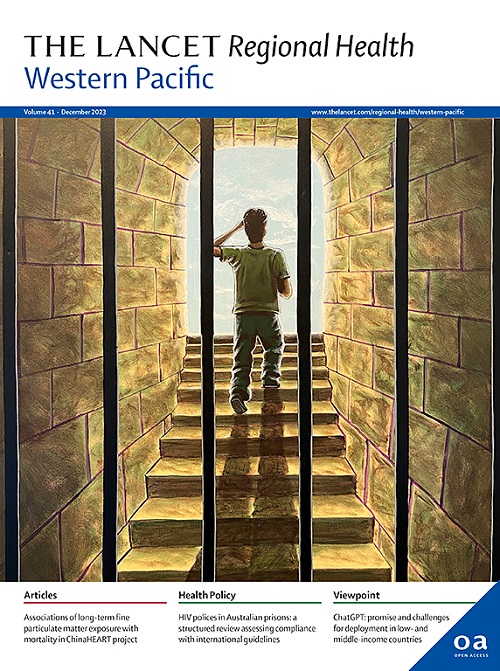限制随意食品和饮料零售商品对人口饮食的影响:一项实用的随机对照试验的试验后随访
IF 8.1
1区 医学
Q1 HEALTH CARE SCIENCES & SERVICES
引用次数: 0
摘要
“健康商店2020”在20个偏远的澳大利亚土著和托雷斯海峡岛民社区商店中进行了一项实用的、部分随机的平行群体试验,测试了一项共同设计的策略,限制零售商销售不健康食品。我们旨在评估健康商店2020对试验后24周游离糖销售的影响。方法由统计学家使用单一随机分配序列将20家商店随机分配到干预组,其中一项策略限制不健康食品的销售(六或七个策略组成部分),或常规零售实践的对照组。该试验是与澳大利亚偏远地区的一个土著组织合作进行的。在试验后(24周),紧接着25周的RCT,干预商店(n = 10)继续该策略,但没有外部实施支持,对照商店(n = 10)继续常规做法。主要结果是使用混合模型对所有食品和饮料中游离糖(g/MJ)购买量(每周销售数据)的影响。次要结果包括食品和饮料的总金额和毛利润(AUD$)和战略实施(通过收集的照片数据评估全面实施的战略数量)。试验注册,ACTRN12618001588280。研究结果:我们观察到试验组和对照组在试验后总游离糖转化为能量方面的差异(- 4.6%,95% CI - 7.1, - 1.9)。两组之间的餐饮总额和毛利分别为7.0%(0.9、13.5美元)和11.4%(4.6、18.6美元)。两家干预店在试验结束时完全实施了所有策略组成部分,八家干预店在试验结束时至少遵守了七个策略组成部分中的四个。一项有利于健康的零售干预在试验后期间显示出糖减少的效果,但对利润没有不利影响。澳大利亚国家健康和医学研究委员会。本文章由计算机程序翻译,如有差异,请以英文原文为准。
Effect of restricted retail merchandising of discretionary food and beverages on population diet: post-trial follow-up of a pragmatic randomised controlled trial
Background
Healthy Stores 2020 tested a co-designed strategy restricting retailer merchandising of unhealthy foods in a community-level pragmatic, partially randomised, parallel group trial in 20 remote Australian Aboriginal and Torres Strait Islander community stores. We aimed to evaluate the impact of Healthy Stores 2020 on free sugar sales 24-weeks post-trial.
Methods
Twenty stores were randomly assigned by a statistician using a single sequence of random assignments to the intervention group, in which a strategy restricted merchandising of unhealthy food (either six or seven strategy components), or to a control group of usual retail practice. The trial was done in partnership with an Indigenous organisation operating in remote Australia. In the post-trial period (24 weeks), immediately following the 25-week RCT, intervention stores (n = 10) continued the strategy but with no external implementation support, and control stores (n = 10) continued usual practice. The primary outcome was impact on purchases (weekly sales data) of free sugars from all foods and beverages (g/MJ) using mixed models. Secondary outcomes included total food and beverage dollars and gross profit (AUD$) and strategy implementation (number of strategies with full implementation assessed via photographic data collected). Trial registration, ACTRN12618001588280.
Findings
We observed a difference in sales of total free sugars to energy between the treatment and control groups post-trial (−4.6%, 95% CI −7.1, −1.9). Between group differences in total food and beverage and gross profit dollars were 7.0% (0.9, 13.5) and 11.4% (4.6, 18.6), respectively. Two intervention stores had full implementation of all strategy components and eight intervention stores had compliance with at least four of the seven strategy components at post-trial end.
Interpretation
A health-enabling retail intervention showed an effect on sugar reduction in the post-trial period without adversely impacting profit.
Funding
Australian National Health and Medical Research Council.
求助全文
通过发布文献求助,成功后即可免费获取论文全文。
去求助
来源期刊

The Lancet Regional Health: Western Pacific
Medicine-Pediatrics, Perinatology and Child Health
CiteScore
8.80
自引率
2.80%
发文量
305
审稿时长
11 weeks
期刊介绍:
The Lancet Regional Health – Western Pacific, a gold open access journal, is an integral part of The Lancet's global initiative advocating for healthcare quality and access worldwide. It aims to advance clinical practice and health policy in the Western Pacific region, contributing to enhanced health outcomes. The journal publishes high-quality original research shedding light on clinical practice and health policy in the region. It also includes reviews, commentaries, and opinion pieces covering diverse regional health topics, such as infectious diseases, non-communicable diseases, child and adolescent health, maternal and reproductive health, aging health, mental health, the health workforce and systems, and health policy.
 求助内容:
求助内容: 应助结果提醒方式:
应助结果提醒方式:


